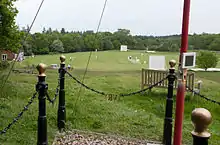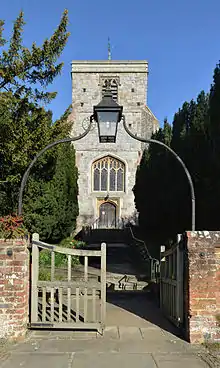Puttenham, Surrey
Puttenham is a village in Surrey, England just south of the Hog's Back which is the narrowest stretch of the North Downs. Puttenham is south of the A31 which runs between Guildford and Farnham along the spine of the Hog's Back. Villages nearby include Wanborough, Shackleford and Compton.
| Puttenham | |
|---|---|
 Puttenham Priory | |
 Puttenham Location within Surrey | |
| Area | 7.88 km2 (3.04 sq mi) |
| Population | 601 (Civil Parish 2011)[1] |
| • Density | 76/km2 (200/sq mi) |
| OS grid reference | SU9348 |
| Civil parish |
|
| District | |
| Shire county | |
| Region | |
| Country | England |
| Sovereign state | United Kingdom |
| Post town | Guildford |
| Postcode district | GU3 |
| Dialling code | 01483 |
| Police | Surrey |
| Fire | Surrey |
| Ambulance | South East Coast |
| UK Parliament | |
Geography
Puttenham lies in the so-called Vale of Holmesdale between the chalky North Downs to the north and Greensand Ridge to the south. To the south west of the village is Puttenham Common.
The houses of Puttenham mainly line the road 'The Street' that runs through it from west to east, making it a largely linear settlement.
History

Puttenham was referred to in the Domesday Book of 1086 and was called Reddesolham or Rodsall. Its domesday assets were owned by the Bishop of Bayeux. Its domesday assets were: 1 plough, 2 acres (0.81 ha) of meadow, woodland worth 4 hogs. It rendered £2 per year to its feudal overlords.[2]
Queen Victoria reviewed some troops from Frowsbury Hill on 7 July 1858.[3]
Puttenham Priory
Puttenham Priory is a large house at the eastern end of the village. The original house dated from 1266 when it was a priory. It was extended 1730 and again in 1762 by Thomas Parker, who added the Palladian front.[4] It is Grade II* listed architecturally, the mid-category.[5] The house was owned from 1970 by David Campbell Cramer who died in or shortly before 1996, and whose body is buried in the country churchyard that is visible from one of the windows. The house retains its features and is now the home of Queen drummer, Roger Taylor.
St John the Baptist church

St John the Baptist church is towards the eastern end of the village. This church was built in stages. The oldest part is late Saxon; in 1160, Norman pillars were built. In the 13th century, the Lady Chapel was added and in the 15th century the tower was added. In the 18th century it was destroyed by fire but was restored in the 20th century.[6][7]
Public house
The village has a pub called The Good Intent. The Good Intent was first mentioned in the 1861 census, but the building has earlier origins.[8]
Puttenham Golf Club
Puttenham Golf Club is a private members club and is one of the oldest golf clubs in Surrey, founded in 1894 by a group of Army Officers, Charterhouse School Masters and local businessmen. The course occupies land on Puttenham Heath and measures 6,220 yards (5,690 m) with a par of 71 from the white tees. The course is a mixture of heath and woodland, the tree-lined fairways have a particularly splendid backcloth of colour with attractive areas of heather and many species of wild flowers.
There are some panoramas on certain tees.
Puttenham Telephone Exchange
Puttenham used to have its own telephone exchange. The telephone exchange building has now been converted to other uses. Telephone numbers were in the form "Puttenham 555", meaning that dialling 555 from numbers on the same exchange would allow the call to be put through. All the old Puttenham telephone numbers have now been converted to the Guildford exchange, by adding "810" before the original 3 digit Puttenham exchange telephone number. Since the STD dialling code for Guildford is now 01483, the original 3 digit number is now dialled as (01483) 810***" where "***" is the original Puttenham exchange 3 digit number. For example, what was Puttenham 555 is now dialled as (01483) 810555.
Puttenham in literature
The village features in Brave New World, a dystopian novel by Aldous Huxley: "Puttenham was a modest little village nine stories high, with silos, a poultry farm, and a small vitamin-D factory."[9]
Natalie Young's Season to Taste (2014) is mostly set in Puttenham.
Sir Arthur Conan Doyle's historical novel Sir Nigel features an outlaw known as "The Wild Man of Puttenham".
Demography and housing
| Output area | Detached | Semi-detached | Terraced | Flats and apartments | Caravans/temporary/mobile homes | shared between households[1] |
|---|---|---|---|---|---|---|
| (Civil Parish) | 107 | 65 | 52 | 16 | 0 | 0 |
The average level of accommodation in the region composed of detached houses was 28%, the average that was apartments was 22.6%.
| Output area | Population | Households | % Owned outright | % Owned with a loan | hectares[1] |
|---|---|---|---|---|---|
| (Civil Parish) | 601 | 240 | 36.3% | 27.9% | 788 |
The proportion of households in the civil parish who owned their home outright compares to the regional average of 35.1%. The proportion who owned their home with a loan compares to the regional average of 32.5%. The remaining % is made up of rented dwellings (plus a negligible % of households living rent-free).
References
- Key Statistics; Quick Statistics: Population Density United Kingdom Census 2011 Office for National Statistics Retrieved 21 November 2013
- Domesday Map Retrieved 30 November 2013
- Puttenham Priory Archived 7 March 2009 at the Wayback Machine
- Historic England. "Details from listed building database (1294505)". National Heritage List for England. Retrieved 30 November 2013.
- St John the Baptist Church Archived 19 May 2010 at the Wayback Machine
- St John the Baptist Church Archived 22 June 2007 at the Wayback Machine retrieved 11 January 2007
- Puttenham in Surrey – Puttenham village landmarks – places of interest The Good Intent Retrieved 30 November 2013
- Brave New World by Aldous Huxley (1894–1963) Chapter Eighteen
External links
| Wikimedia Commons has media related to Puttenham, Surrey. |
